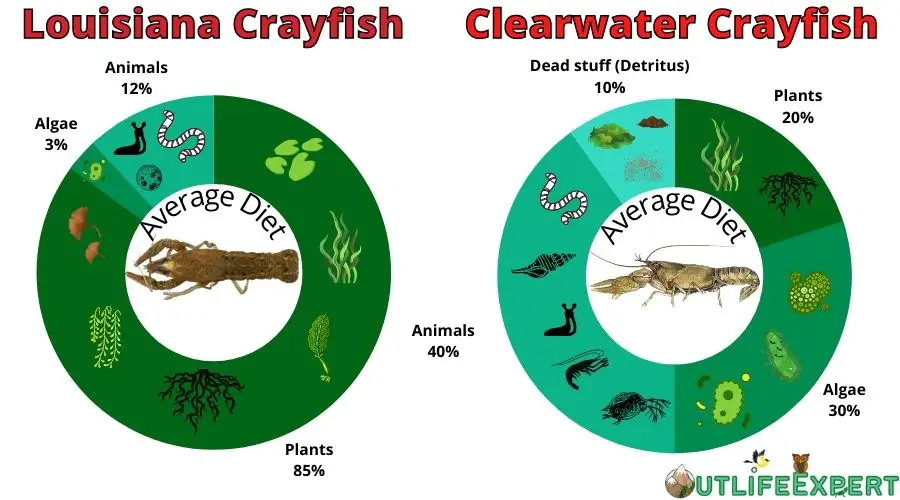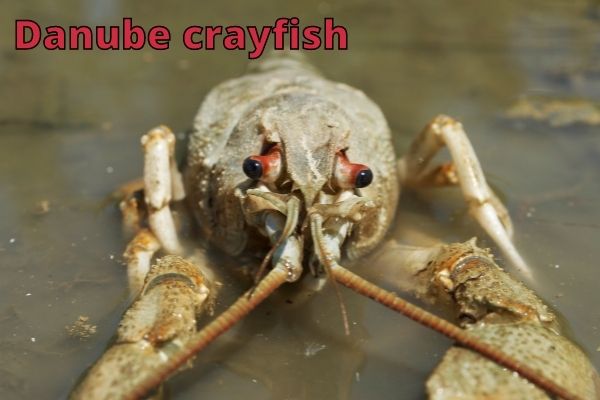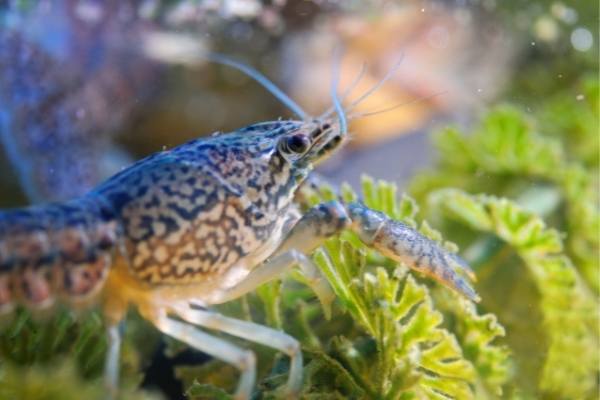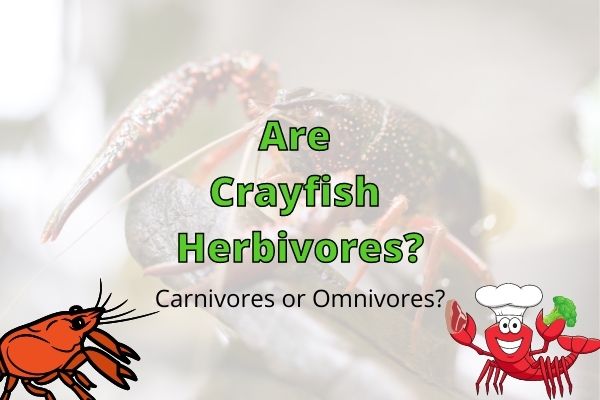Crayfish are freshwater crustaceans that live in streams, rivers, lakes and ponds. They are related to shrimp, crabs and lobsters and are an important part of the food web in their ecosystem.
Crayfish are mostly herbivorous animals and eat a variety of plant matter like algae, aquatic plants, seeds and roots but they do actually prefer to eat animals – and they may be more carnivores than we think!
Whereas crayfish are of though to primarily feed on plants and algae, but in fact a substantial part of their diet is made up of soft bodied animals. Crayfish are opportunistic feeders and they will eat smaller animals if they can catch them.
Crayfish do not need to eat plant material but they often do so to prevent starvation as plants require less effort from them to eat and are more widely available.
Their diet changes based on what is available in their environment and what living or dead prey they can find.
There are dozens of species of crayfish, and they are found on every continent except Antarctica. Some species live in salt water, and some even live in brackish water, meaning the water they live in is a mixture of fresh and salt water.
Contents
Primary Diet of Crayfish
Crayfish are omnivores, which means they eat both plants and animals. Crayfish eat algae, plants, small animals, and dead animals. Crayfish are also scavengers, which means they eat dead animals.
Their mouths are attached to a pair of mandibles that have four claws that are used to crush and eat prey. Their claws are also used to grasp small rocks and other items as they swim.
Crayfish are typically feed in rivers, streams, and lakes but some may also enter land temporarily. They are generally considered a bottom feeders so they rarely swim to the surface and they hide in their burrows most of the day as they are mainly active at night (they are nocturnal).
However, as you will see, the diet of a crayfish depends on many factors such as species, habitat, age and season.

From the figure above, you can see how too species of crayfish clearly have different amounts of animals and plants in their diet and are therefore herbivores and carnivores (both omnivores) to a different extent.
This is not only true between species, but also between growth stages (age) and habitats of crayfish where the diet may change substantially from season to season depending on what foods are available.
Are Crayfish Carnivores, Herbivores or Omnivores?
Crayfish are omnivores because they eat both plant material and animals. Interestingly, it was long thought that crayfish were primarily herbivores and they did not care where they got their nutrients from, as long as they got plenty of calories and protein.
Whereas overall food quality is important for crayfish, animal protein seems to play a unique role in their diet. And indeed, studies show that the growth rate of crayfish is increased when they eat soft animal foods like snails and mussels, and they continue to grow rapidly during times of plentiful food.
Depending on the species, crayfish get between 6% and 80% of their food by eating other animals, but few crayfish feed entirely on animals.
In addition, many ecologists and aquaculturists view crayfish as detritivores. This view is based on the digestive contents of crayfish, which emphasize indigestible residues but may sometimes ignore the ingestion of soft-bodied animals like slugs, worms and snails.
However, it is clear that most species of crayfish only feed as herbivores if animal prey is not widely available. And some species like the Turkish crayfish or Danube crayfish (Pontastacus leptodactylus) is known to get 74-80% of its food from animals – making it more of a carnivore than herbivore!

And studies have shown that especially adult crayfish have a strong preference for animal protein that they consume as active predators or as scavengers.
Therefore, crayfish may even be viewed as key predators in some aquatic systems that can disrupt the ecosystem if crayfish are introduced at a time where smaller animals are vulnerable.
What animals do crayfish eat?
Crayfish eat a variety of animals including insects, snails, worms, and small fish. They will forage around on the bottom of the lake and stream where they live, and while they prefer to scavenge for dead animals, this can be a dangerous strategy.
Catfish, one of the main predators of crayfish, are also scavengers and they may encounter each other during a meal (the last meal for the crayfish, that is!).
Therefore, the crayfish often hunt for smaller animals like worms or snails and slugs. They may also try to eat tadpoles or frogs when they spawn in the spring. They need to be careful though, as some frogs also eat crayfish!
Generally, crayfish will eat the following animals:
- Dead or dying fish
- Other (smaller) crayfish
- Zooplankton
- Worms
- Aquatic snails
- Slugs
- Smaller shrimp
- Insects
- Mussels
They may also try to fight other crayfish for territory and mates, which sometimes lead to fatalities and a good meal for the winner!
Will Crayfish Eat Plants?
Yes, as mentioned, many crayfish species are known to be omnivores, meaning that they will eat both plants and animals.

The type of plant matter that they consume depends on the availability in their environment and can include things like algae, aquatic plants, and detritus of plants.
What plants do crayfish eat?
Whereas crayfish may eat plants that fall into the water from the surface, they are particularly fond of aquatic plants, such as duckweed, and water lilies.
Crayfish seems to prefer short plants that grow from the bottom with soft stems and leaves. But they also feed on the roots of many other plants for example the sea clubrush.
The most common plants eaten by crayfish are:
- Cattails (roots)
- Clubrush (its roots)
- Hydrilla
- Water hyacinth
- Duckweed
- Various seeds
- Dead leaves
- Terrestrial plants that fall into water
Crayfish may even go so far to enter land and eat plants like grass or clovers!
However, crayfish cannot stay for long on land as their gills need to be wet for them to breathe properly.
Can crayfish survive on algae?
Yes! Especially as juveniles, crayfish eat a large portion of their food as algae. Including microalgae and cyanobacteria, but also macroalgae such as different seaweeds.
Some species of algae that crayfish eat are:
- Chlorella
- Euglena
- Spirogyra
- Ulothrix
- Pleurococcus
- Micromonas
Although they prefer animals as the main substance of their diet, it often takes more time and energy to feed on animals, and they risk getting hurt, so most crayfish will eat algae and plants as a substantial part of their diet.
In fact, some crayfish species, like the Louisiana crawfish and the white river crayfish survive on around 90% of their food from plants and algae when soft bodied animals like worms and slugs are scarce.
Are Crayfish Producers, Consumers or Decomposers?
Crayfish are consumers because they eat other living organisms. Crayfish are omnivores, which means that they eat plants and animal matter. Only plants as well as some bacteria and protozoa are true producers.
Crayfish are not considered decomposers in the classical sense but they do act as detritivores or scavengers.
What Type of Consumer is a Crayfish?
Crayfish are primary consumers but also secondary consumers because they eat plants and animals.
Generally, herbivores are primary consumers, omnivores like crayfish are secondary consumers and carnivores are tertiary consumers.
Whereas they can also be considered secondary consumers, which means that they feed on other animals, they are not tertiary consumers because their diet always includes some plant material.
While the two groups do not necessarily overlap or exclude each other, crayfish may therefore serve as both primary and secondary consumers.
Are Crayfish Decomposers?
No. Crayfish do not eat dead or decaying matter and are therefore not decomposers. However, they do filter out dead organic matter from the water, which means that they are helping the decomposition of organic matter.
They will, however, eat dead animals that sink to the bottom and therefore they can be considered as scavengers. Common carrion includes dead fish, amphibians, and invertebrates.
They love the smell of dead animals, but they are also competing with many other animals like scavenging fish for the carrion and some of these fish might also feed on crayfish!
This is why the best bait to use when fishing for crayfish is meat scraps!
The bacteria in the gut of the crayfish play a very important role for their digestion and these microorganisms may be considered true decomposers.
Where are Crayfish in the Food Chain?
Crayfish are the first trophic level in the energy pyramid because they are primary consumers. They eat plants, algae, bacteria and some amounts of microscopic crustaceans (zooplankton) which place them at the 2nd and 3rd trophic levels.
Those who fish probably already know a lot about the aquatic food web without realizing it. It is important to determine the food chain in a lake. Without balance, the ecosystem will collapse.
The food web is a conceptual way of looking at who is eating what and how, and the concept of everything related in a lake. The reason that biologists use the term food web to describe that aquatic food system rather than food chain is because it’s a better way to visualize that everything is interconnected in a lake.
The animals like crayfish and crabs that live at the bottom of the lake and like to eating algae, plants and small animals are called bottom feeders. As they grow, they may also consume smaller sized fish and even other members of their own species!
Lakes are complex ecosystems with multiple players, each keeping the rest in balance. If the players that keep things in balance suddenly stop doing their jobs, the entire system starts to go wrong.
So, for example, if the main food animal for larger fish (like Bass or Perch) in the lake is the crayfish and the crayfish mainly consume the zooplankton and invertebrates while the predator fish have no predators, then there will eventually be an imbalance of larger predatory fish.

The food web must start at the bottom with the sun and the light that allows plants and algae to grow and there has to be members present that can transfer the energy from these plants and algae all the way up through the food chain. Otherwise, no one will really do well in that ecosystem and it will be out of balance.
After bacteria, other microbes and plants, the food web includes crustaceans like crabs and crayfish, aquatic insects and fish. The group of predatory fish includes bass, muskies and northern pike. A balanced food chain is an amazing balancing act.
Are Crayfish Autotrophs or Heterotrophs?
Crayfish are heterotrophs because they eat other living organisms. Practically no animals are autotrophic because animals do not get their energy directly from the sun like plants do.
Autotrophic organisms make their own food using carbon-containing molecules from their environment. Heterotrophic animals, on the other hand, ingest food by eating other organisms or decaying organic matter. There are very few autotrophic animals, but there are many protists (single celled animals) that are.
That is, animals like the crayfish cannot make their own energy!
What Animals Prey on Crayfish?
Besides humans, crayfish are also eaten by many types of animals including owls, foxes, and snakes. But I won’t go more into the enemies of crayfish here, as I already wrote two articles about what fish eat crayfish and what other (land) animals eat crayfish.
Conclusion
We have look into crayfish and their placement in the food chain and whether they are herbivores or not.
Whereas the diet of crayfish appears to change over time, it is quite clear by not that they do not restrict themselves to plants or animals. While small crayfish are considered mostly herbivorous, they are believed to get more carnivorous as they grow older and are able to catch larger prey.
Studies on the stomach contents of crayfish suggest that their diets shift from herbivorous to carnivorous as they age.
Future studies on stable isotope analyses may reveal that most species of crayfish are carnivorous throughout their lives, but this is not fully established yet.
Crayfish are a type of freshwater crustacean that can be found in ponds, lakes, and rivers. They are scavengers, meaning they eat whatever they can find.
Crayfish are very important to the ecosystem because they help clean the water by eating algae and other plant material. They also help control the amount of dead animal material in the water by eating it.
Crayfish are also important to humans because they are a source of food. They are eaten in many countries around the world.




